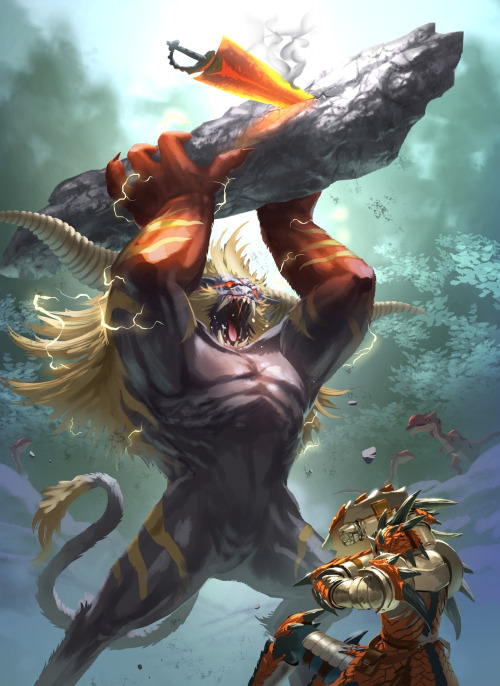
Table of Contents
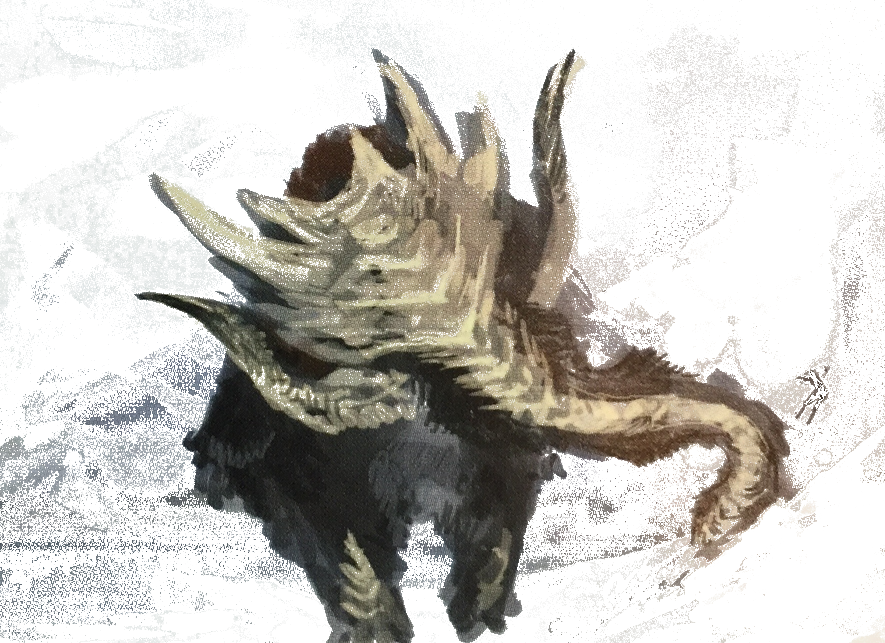
Fanged Beasts
Once known as Pelagus, Fanged Beasts are mammalian creatures with no wings. They are often much faster than other larger threats, but not all of them are aggressive. Many of these beasts will ignore adventurers unless they make themselves known or startle the beast. While other Fanged Beasts attack on site, using the environment and speed to their advantage.
Fanged Beasts exhibit a wide variety of dietary habits; some are strictly herbivorous or carnivorous, while others subsist on insects. Most of them have unique attribute for survival, such as powerful forelimbs or large tusks, and are well evolved for the environment they live in. Others form packs, with the strongest of them as the Alpha.
Bullfango
Medium beast (fanged), unaligned
- Armor Class 11 (natural armor)
- Hit Points 11 (2d8+2)
- Speed 40 ft.
STR DEX CON INT WIS CHA 13 (+1) 11 (+0) 12 (+1) 2 (-4) 9 (-1) 5 (-3)
- Senses passive Perception 9
- Languages -
- Challenge 1/4 (50xp)
Charge. If the bullfango moves at least 20 feet straight toward a target and then hits it with a tusk Attack on the same turn, the target takes an extra 3 (1d6) slashing damage. If the target is a creature, it must succeed on a DC 11 Strength saving throw or be knocked prone.
Aggressive. As a bonus action, the bullfango can move up to its speed toward a hostile creature that it can see.
Actions
Tusk. Melee Weapon Attack: +3 to hit, reach 5 ft., one target. Hit 4 (1d6 + 1) slashing damage.
Bullfango & Bulldrome
Although veteran adventurers can generally take a bullfango out easily, they can be dangerous for beginners and may even pose a threat to more experienced adventurers when several attack at once. Bulldromes on the other hand have larger tusks than Bullfango, and a layer of white fur, as opposed to Bullfango's black fur. Bulldromes are more agile when running and proficient at finding and locking onto their victims. These Fanged Beasts are sometimes found in packs and will charge at all intruders once noticed. They are very territorial, and can be a considerable nuisance.
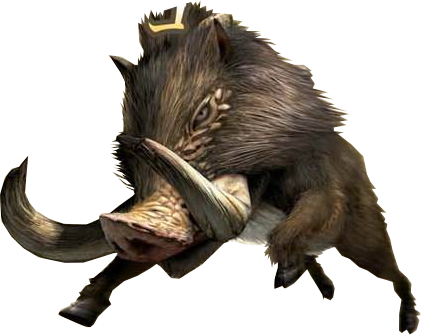
Bulldrome
Large beast (fanged), unaligned
- Armor Class 12 (natural armor)
- Hit Points 59 (7d10+21)
- Speed 40 ft.
STR DEX CON INT WIS CHA 17 (+3) 11 (+0) 16 (+3) 2 (-4) 7 (-2) 5 (-3)
- Senses passive Perception 8
- Languages -
- Challenge 2 (450xp)
Charge. If the bulldrome moves at least 20 feet straight toward a target and then hits it with a tusk Attack on the same turn, the target takes an extra 7 (2d6) slashing damage. If the target is a creature, it must succeed on a DC 13 Strength saving throw or be knocked prone.
Aggressive. As a bonus action, the bulldrome can move up to its speed toward a hostile creature that it can see.
Actions
Tusk. Melee Weapon Attack: +5 to hit, reach 5 ft., one target. Hit 10 (2d6 + 3) slashing damage.
Thrash (recharge 5-6). The bulldrome thrashes about striking all creatures within 5-foot radius of it. Each creature in the area much make a DC 10 Dexterity saving throw, taking 7 (2d6) slashing damage on a fail or half as much on a successful save.
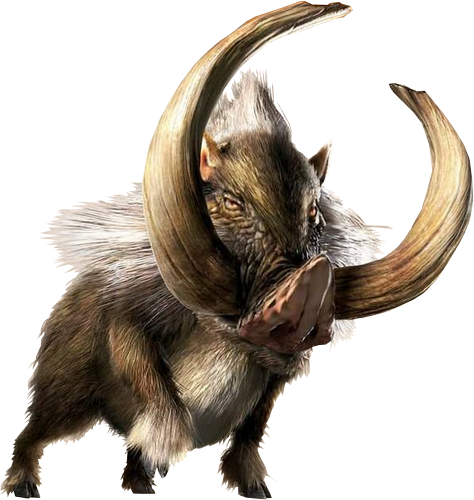
Lagombi
A large, wombat-like Fanged Beast. Its ears are long and highly sensitive, and its face features a beak-like mouth along with small red eyes. A Lagombi's belly is made of a low-friction material and is shaped so that it can slide upon the ice like a sled. It is covered in a thick fur coat to keep it warm in its sub-zero homeland.
A Lagombi has superb hearing in order to remain aware of predators. It attacks by throwing chunks of ice, swiping with its claws, and sliding around on its belly in order to ram foes. To traverse from area to area it slides on its belly much like a penguin. Lagombi is a relatively docile monster, but will respond with aggression when provoked or threatened. It is evidently an insectivore, as it enjoys feeding on Bnahabra.
Lagombi
Large beast (fanged), unaligned
- Armor Class 14 (natural armor)
- Hit Points 110 (13d10+39)
- Speed 40 ft.
STR DEX CON INT WIS CHA 16 (+3) 12 (+1) 16 (+3) 2 (-4) 7 (-2) 5 (-3)
- Skills Acrobatics +3, Perception +0
- Senses passive Perception 10
- Languages -
- Challenge 3 (700xp)
Ice Walker. The Lagombi is accustomed to moving through the frozen tundras, as such it ignores difficult terrain for snow, ice, and other cold weather effects.
Slide. The lagombi’s reflexes and agility allow it to move with a burst of speed. When it moves on its turn in combat, it can double its speed while traveling in a straight line. If the Lacombi runs into a creature after moving at least 20 feet the creature must make a DC 13 Strength saving throw or be knocked prone. The Lacombi cannot use this skill again until it moves 0 feet on one of its turns.
Actions
Multiattack. The Lacombi makes two claw attacks, it can replace one of these attacks with its giant snowball attack.
Claws. Melee Weapon Attack: +5 to hit, reach 5 ft., one target. Hit 12 (2d8 + 3) slashing damage.
Giant Snowball. Range Weapon Attack: +3 to hit, reach 60/100 ft., one target. Hit 6 (1d10 + 1) bludgeoning damage plus 5 (1d10) cold damage.
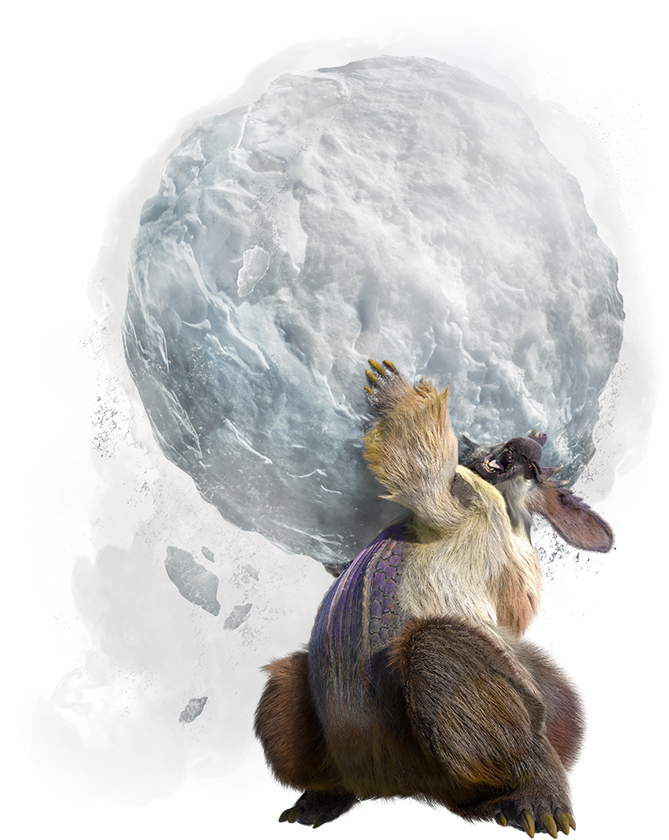
Arzuros
Arzuros is noted for its turquoise colored fur and ursine body structure. It has a ridge of erect hair aligned with its nose. Its back is made of a tough hide, somewhat characteristic of a carapace. Hair runs from its cheeks, connecting to its back, where it forms a trim along the sides of the back. The claws of an Arzuros have elongated, red nails. Each claw has a tough brace encasing and protecting the wrist and forearm. Arzuros has large, bulky legs connected to much smaller feet and a short, wide tail.
Arzuros is armed with two vicious claws which it uses for most of its attacks. It can use its large body and surprising agility for charge attacks and pinning down prey.
Arzuros are omnivorous creatures that enjoy feasting on fish and honey. When eating honey, Arzuros pays little to no attention to its surroundings. When threatened by other large monsters, Arzuros will try to use its size and claws to frighten the monster, or will use its agility to escape. Arzuros often hangs its tongue out of its mouth.
Arzuros
Large beast (fanged), unaligned
- Armor Class 14 (natural armor)
- Hit Points 90 (12d10 + 24)
- Speed 35 ft.
STR DEX CON INT WIS CHA 18 (+4) 12 (+1) 14 (+2) 8 (-1) 8 (-1) 8 (-1)
- Senses passive Perception 9
- Languages -
- Challenge 4 (1,100 XP)
Aggressive. As a bonus action, the arzuros can move up to its speed toward a hostile creature that it can see.
Actions
Multiattack. The arzuros makes three melee attacks: one bite attack, one claw attack, and one body slam attack.
Bite. Melee Weapon Attack: +6 to hit, reach 5 ft., one target. Hit 13 (2d8 + 4) piercing damage.
Claw. Melee Weapon Attack: +6 to hit, reach 5 ft., one target. Hit 11 (2d6 + 4) slashing damage.
Body Slam. Melee Weapon Attack: +6 to hit, reach 5 ft., one target. Hit 15 (2d10 + 4) bludgeoning damage.
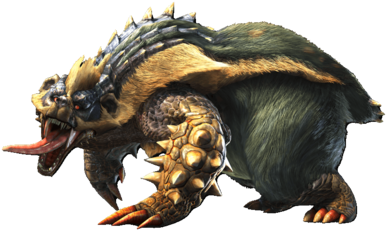
Volvidon
Large beast (fanged), unaligned
- Armor Class 16 (natural armor)
- Hit Points 112 (15d10 + 30)
- Speed 30 ft.
STR DEX CON INT WIS CHA 14 (+2) 16 (+3) 14 (+2) 5 (-3) 10 (+0) 3 (-4)
- Senses passive Perception 10
- Languages -
- Challenge 5 (1,800 XP)
Pull in. As a bonus action, the volvidon can pull a grappled target 10 ft. towards them.
Actions
Multiattack. The volvidon makes three attacks: one tongue attack and two claw attacks.
Tongue. Melee Weapon Attack: +6 to hit, reach 15 ft., one target. Hit 14 (2d10 + 3) bludgeoning damage and a Large or smaller target is grappled (escape DC 13). Until this grapple ends, the target is restrained, and the volvidon can't use this attack on another target.
Claw. Melee Weapon Attack: +6 to hit, reach 5 ft., one target. Hit 10 (2d6 + 3) slashing damage.
Rollout (recharge 5-6). The volvidon curls up into a ball, releasing any grappled creature, and moves up to double its speed in a straight line. If the volvidon passes through a creatures space, that creature must make make a DC 13 Dexterity saving throw, taking 21 (6d6) bludgeoning damage and are knocked prone on a failed save. On a successful save, the target takes half damage and is not knocked prone.
Volvidon
Volvidon is covered in a series of red armor plates, which are segmented around the midsection and allow the Volvidon to curl into a ball. It possesses an extremely long, chameleon-like tongue which is covered in sticky saliva. Being a Fanged Beast, the Volvidon uses attacks similar to those of Arzuros and Lagombi. It is known to pull prey and foes toward its mouth using its long tongue. In addition to aiding transportation, its ability to roll up into a ball allows it to crush foes during combat. It will typically avoid trouble, but if cornered, Volvidon can be surprisingly aggressive.
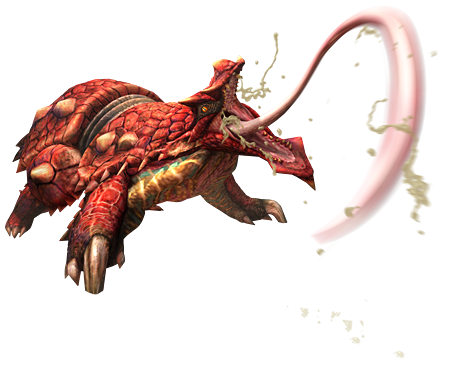
Kecha Wacha
Kecha Wacha is a lemur-like monster with long arms and hook-like fingers and claws. It has bright yellow fur and blue skin. It can fold its spiked ears over its face, forming a "mask" that is likely used to intimidate would-be attackers. It also sports a tube-like trunk and large, forward-facing eyes.
It is capable of attacking from a distance by shooting globs of mucus from its trunk-like nose which cause Waterblight. Kecha Wacha is able to glide using a membrane between its arms, legs, and tail, in a manner similar to a flying squirrel. This makes the Kecha Wacha the only Fanged Beast able to "fly".
Kecha Wachas thrive in areas where they can climb and swing around freely. These creatures have a varied diet as they are omnivores. Kecha Wacha will feed on vegetation, fruits, seeds, along with insects such as Altaroth, Konchu, grubs, or Bnahabra.
Curious in nature Kecha Wacha will investigate anything in their environment that is new to them. As relatively peaceful monsters these creatures would rather flee than fight, yet if fleeing is not an option they can be surprisingly aggressive and will readily use their long, sharp, and hooked claws, trunk-like nose and mask-like ears to defend themselves.
Kecha Wacha
Large beast (fanged), unaligned
- Armor Class 13
- Hit Points 142 (15d10 + 60)
- Speed 30 ft., climb 30 ft., glide 40 ft.
STR DEX CON INT WIS CHA 21 (+5) 14 (+2) 18 (+4) 7 (-2) 12 (+1) 7 (-2)
- Skills Athletics +8, Perception +4
- Senses passive Perception 14
- Languages -
- Challenge 6 (2,300 XP)
Spider Climb. The kecha wacha can climb difficult surfaces, including upside down on ceilings, without needing to make an ability check.
Gliding. When the kecha wacha glides, it loses 5 feet of altitude for every 5 feet of movement. At the end of its glide the kecha wacha falls to the ground if it is still in the air.
Actions
Multiattack. The kecha wacha makes three claw attacks. It can replace any of these attacks with its mucus attacks.
Claws. Melee Weapon Attack: +8 to hit, reach 5 ft., one target. Hit: 14 (2d8 + 5) piercing damage.
Mucus. Range Weapon Attack: +8 to hit, range 30/120 ft., one target. Hit: 10 (3d6) acid damage and the target is poisoned with waterblight for 1 minute.
Tantrum (recharge 5-6). The kecha wacha flails its fist all around it in anger. Each creature within 10 feet of the kecha wacha must make a DC 17 Strength saving throw, taking 28 (8d6) bludgeoning damage on a failed save or half as much on a successful one.
Reactions
Earmuffs. When the kecha wacha is targeted by a spell or attack it can use its reaction to fold its ears down over its face until the start of its next turn. While its ears are covering its face, it gains +1 AC and is considered deafened.
Poison: Waterblight
A creature affected by waterblight has their stamina drained
- On the creatures turn, it can use either an Action or a Bonus Action, not both.
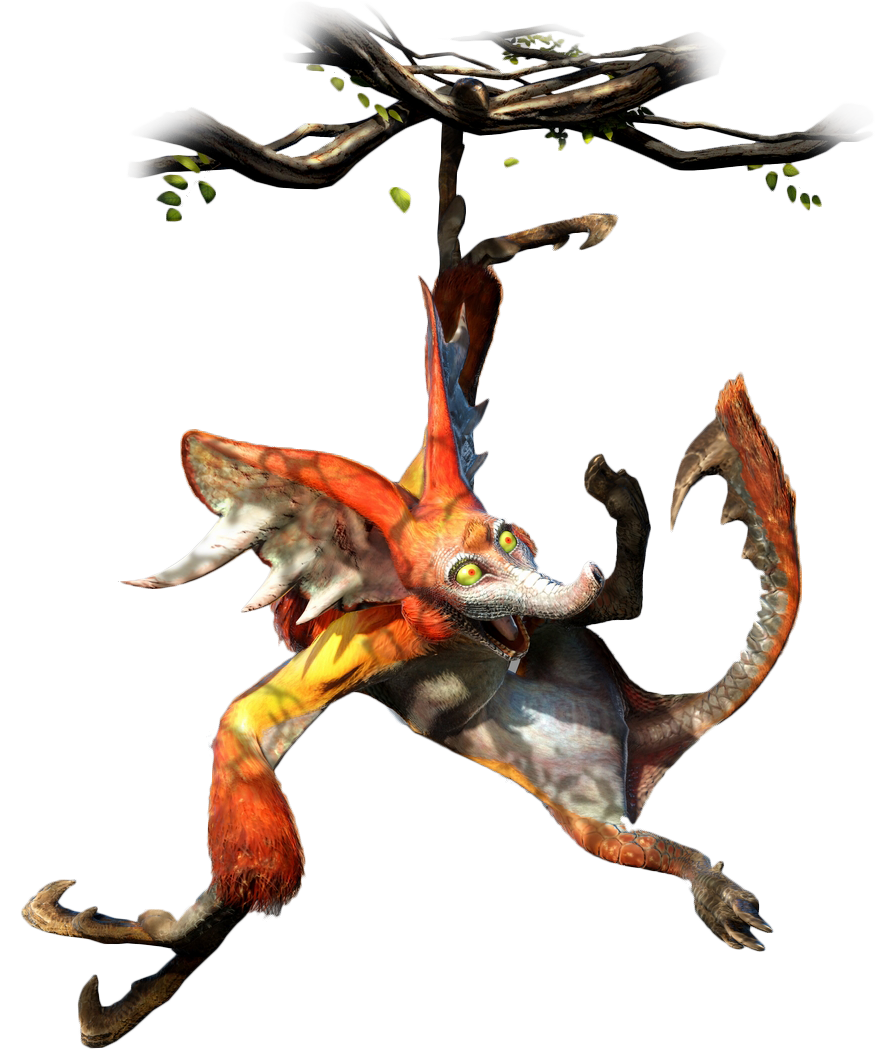
The Conga & Congalala
They resemble pink gorillas with a face of a hippopotamus, black underbellies. The Conga have a blonde patch of hair on top of their head while the Congalala spike on its head is actually hair that the Congalala has smoothed into shape to signify that they are the pack leader. Congalalas are surprisingly intelligent beasts.
Despite their apparently adorable appearance, the Conga & Congalala should never be underestimated. While they are for the most part very docile, they react well to the presence of herbivores, so long as they give a wide berth. They can quickly become aggressive to anything that disrupts feeding or startles them, for example, if they see Adventurers.
Congas are known for their ability to charge at hunters, like Bullfangos (but slower), travel in packs, and fart on enemies. While the Congas are known for their foul breath attack which varies based on their diet.
Conga
Medium beast (fanged), unaligned
- Armor Class 12
- Hit Points 19 (3d8+6)
- Speed 30 ft., Climb 30 ft.
STR DEX CON INT WIS CHA 16 (+3) 14 (+2) 14 (+2) 6 (-2) 12 (+1) 7 (-2)
- Skills Acrobatics +4, Perception +3
- Senses passive Perception 13
- Languages -
- Challenge 1 (200xp)
Actions
Multiattack. The conga makes two fist attacks.
Fist. Melee Weapon Attack: +5 to hit, reach 5 ft., one target. Hit 6 (1d6 + 3) bludgeoning damage.
Fart. The conga release a noxious odor from its behind at a target within 5 feet of it. The target must make a DC 13 Constitution saving throw or have disadvantage on all Concentration checks for 1 minute.
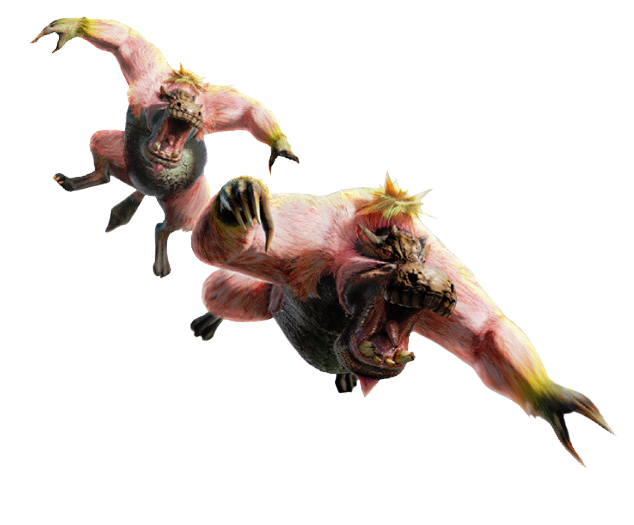
Congalala
Large beast (fanged), unaligned
- Armor Class 13
- Hit Points 142 (15d10+60)
- Speed 40 ft., Climb 40 ft.
STR DEX CON INT WIS CHA 21 (+5) 14 (+2) 18 (+4) 12 (+1) 14 (+2) 7 (-2)
- Skills Acrobatics +5, Perception +5
- Senses passive Perception 15
- Languages -
- Challenge 6 (2,300xp)
Mushroom Eater. All congalala love to eat mushrooms, so much so that they always carry one around their tail. Roll 1d6, the number determines the element of the mushroom the congalala has with it. 1=fire; 2=poison; 3=lightning; 4=cold; 5=acid; 6=necrotic.
Actions
Multiattack. The congalala makes two fist attacks.
Fist. Melee Weapon Attack: +8 to hit, reach 5 ft., one target. Hit 14 (2d8 + 5) bludgeoning damage.
Belly Thrust. Melee Weapon Attack: +8 to hit, reach 5 ft., one target. Hit 16 (2d10 +5) bludgeoning damage.
Chow Down(recharge 6). The congalala eats part of its mushroom then breaths a noxious gas at its prey in a 15 foot cone. Each creature in that area must make a DC 15 Dexterity saving throw taking 28 (8d6) damage of the mushroom's type on a failed save or half as much on a successful one.
Reactions
Belly Thrust. When the congalala is hit by a melee attack, it can use its reaction to make a belly thrust attack against the creature.
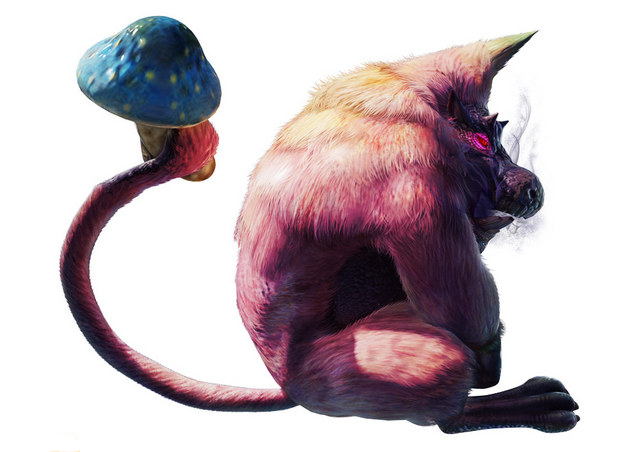
Blango
Medium beast (fanged), unaligned
- Armor Class 12
- Hit Points 39 (6d8+12)
- Speed 30 ft., burrow 30 ft.
STR DEX CON INT WIS CHA 15 (+2) 14 (+2) 14 (+2) 3 (-4) 13 (+1) 6 (-2)
- Skills Athletics +4, Perception +3
- Senses passive Perception 13
- Languages -
- Challenge 1/2 (100xp)
Actions
Multiattack. The blango makes two fist attacks.
Fist. Melee Weapon Attack: +4 to hit, reach 5 ft., one target. Hit 5 (1d6 + 2) bludgeoning damage.
Ice Chunk. Range Weapon Attack: +4 to hit, reach 20/60 ft., one target. Hit 2 (1d4) bludgeoning damage plus 2 (1d4) cold damage.
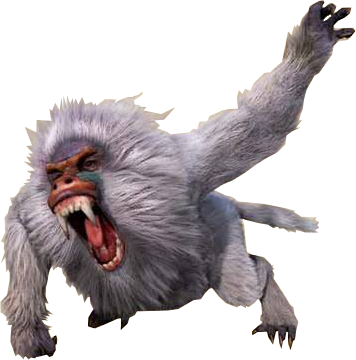
The Blango & Blangonga
White-furred, ape-like creature with a bright red face. The skin beneath its coat is a dull purple color. The Blango can burrow underneath the snow in wait for prey or stalk the rock and ice above. Blangos frequently hunt in packs. Although weak when fighting alone, Blango will fight ferociously when led by a Blangonga. As the alpha-male of the pack, the Blangonga is twice as large as the average Blango and recognized by its giant fangs, whiskers, head-crown, and with a much more aggressive temperament. Its strong, muscled limbs allow it to run and leap at a startling speed. Blangongas are incredibly aggressive creatures. They will ruthlessly attack adventurers and prey, yet shy away from anything larger than themselves. Blangonga live almost exclusively in the snowy climates. Their thick coat keeps them warm and serves as the perfect camouflage
By calling out to its pack, the Blangonga can summon Blangos to fight beside it in battle. Its deadly speed can bewilder the novice adventurer, as they can perform a charge that can send them rolling into their foes and deal out massive damage. Blangongas can break ice at their feet and hurl it at adventurers, or spray ice shrapnel that can tear foes apart.
Blangonga
Large beast (fanged), unaligned
- Armor Class 18 (natural armor)
- Hit Points 161 (17d10+68)
- Speed 40 ft., burrow 40 ft.
STR DEX CON INT WIS CHA 19 (+4) 17 (+3) 18 (+4) 13 (+1) 8 (-1) 10 (+0)
- Saving Throws Str +8, Dex +7, Wis +3
- Skills Athletics +8, Perception +3
- Damage Resistances cold
- Senses passive Perception 13
- Languages -
- Challenge 9 (5,000xp)
Charge. If the blangonga moves at least 20 feet straight toward a target and then hits it with a Fist Attack on the same turn, the target takes an extra 9 (2d8) bludgeoning damage. If the target is a creature, it must succeed on a DC 16 Strength saving throw or be knocked prone.
Actions
Multiattack. The blangonga makes three fist attacks. It can use Ice Boulder in place of any melee attack.
Fist. Melee Weapon Attack: +8 to hit, reach 5 ft., one target. Hit 13 (2d8 + 4) bludgeoning damage.
Ice Boulder. Range Weapon Attack: +8 to hit, reach 30/120 ft., one target. Hit 4 (1d8) bludgeoning damage plus 4 (1d8) cold damage.
Ice Spray (recharge 5-6). The blangonga exhales a spray of ice shards in a 30 foot cone. Each creature in that area must make a DC 16 Dexterity saving throw, taking, 42 (12d6) cold damage on a fail or half damage on a success.
Reactions
Retreat. When the blangonga is hit by a melee attack, it can use its reaction disengage and leap backwards 20 feet.
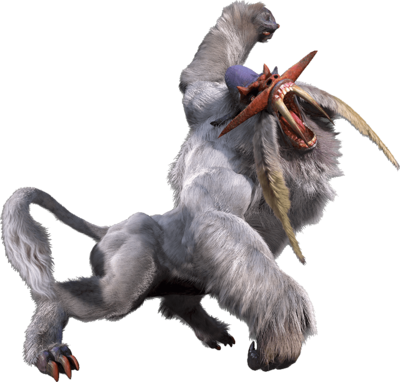
Rajang
The rajang is a ultra-aggressive creature that is rarely sighted and seldom survived. Widely regarded as the pinnacle in unparalleled physical prowess The Rajang is said to be a loner, and this isolated life has made it difficult to pin down its territorial leanings.
The Rajang strongly resembles the Blangonga in its appearance and movement, even borrowing some of its attacks. However, notable differences include Rajang's broader muscles, large horns, hairy tail tip and its ability to use electricity-based attacks. The Rajang's most notable attack is its ability to shoot electricity from its mouth, either as a blast or a beam. They are hated by many adventurers, due to their combination of speed, aggression and power.
Rajang
Huge beast (fanged), unaligned
- Armor Class 17 (natural armor)
- Hit Points 200 (16d12+96)
- Speed 40 ft., climb 40 ft.
STR DEX CON INT WIS CHA 24 (+6) 12 (+1) 23 (+6) 12 (+1) 16 (+3) 10 (+0)
- Saving Throws Str +11, Dex +6, Wis +8
- Skills Athletics +11, Perception +8
- Damage Resistances lightning
- Senses passive Perception 18
- Languages -
- Challenge 15 (13,000xp)
Charge. If the rajang moves at least 20 feet straight toward a target and then hits it with a Fist Attack on the same turn, the target takes an extra 13 (3d8) bludgeoning damage. If the target is a creature, it must succeed on a DC 19 Strength saving throw or be knocked prone.
Standing Leap. The rajang's long jump is up to 30 feet and its high jump is up to 15 feet, with or without a running start.
Actions
Multiattack. The rajang makes two fist attacks.
Fist. Melee Weapon Attack: +11 to hit, reach 5 ft., one target. Hit 19 (3d8 + 6) bludgeoning damage.
Kick. Melee Weapon Attack: +11 to hit, reach 10 ft., one target. Hit 13 (2d6 + 6) bludgeoning damage.
Meteor (Recharge 6). The rajang jumps at least 15 feet as part of its movement, it can then use this action to roll into a ball and come crashing down in a space, within 40 feet of it, that contains one or more creatures. Each of those creatures must succeed on a DC 19 Strength or Dexterity saving throw (target's choice) or be knocked prone and take 14 (3d6 + 6) bludgeoning damage plus 16 (4d6) lightning damage. On a successful save, the creature takes only half the damage, isn't knocked prone, and is pushed 5 feet out of the rajang's space into an unoccupied space of the creature's choice. If no unoccupied space is with in range, the creature instead falls prone in the rajang's space.
Lighting Breath (recharge 5-6). The rajang exhales lightning in a 90-foot line that is 5 feet wide. Each creature in that line must make a DC 19 Dexterity saving throw, taking 45 (10d8) lightning damage on a failed save, or half as much damage on a successful one.
Legendary Actions
The rajang can take 3 legendary actions, choosing from the options below. Only one legendary action option can be used at a time and only at the end of another creatures turn. The rajang regains spent legendary actions at the start of its turn.
Move. The rajang moves up to its speed without provoking opportunity attacks.
Kick. The rajang makes one Kick attack.
Quake (Costs 2 Actions). The rajang reaches for the sky and slams its body onto the ground causing the ground to shake violently. Each creature within 30 feet of the rajang must succeed on a DC 19 Strength saving throw or be knocked prone. Any creature that fails this save by 5 or more is also stunned until the end of their next turn.
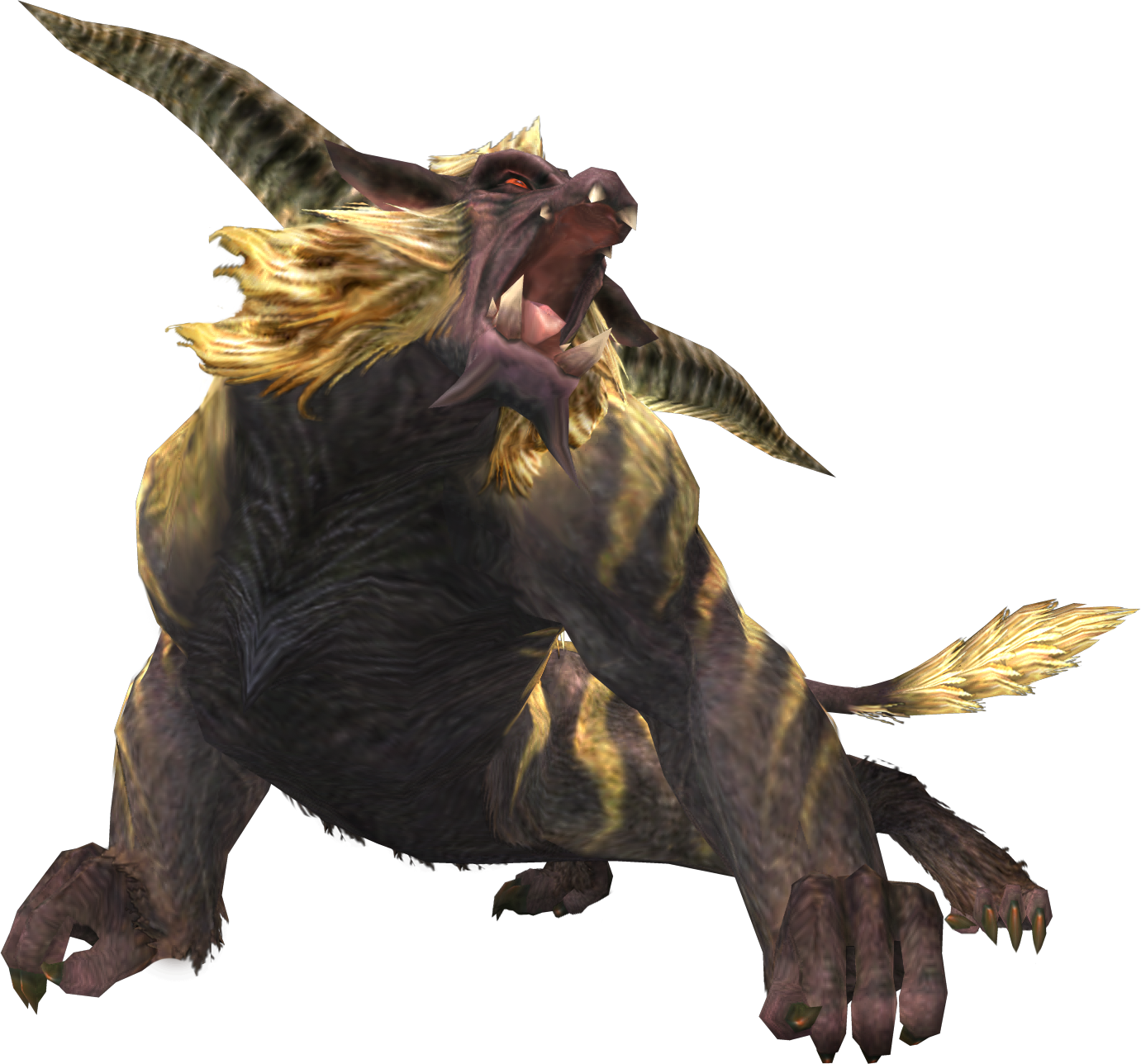
Gammoth
"Found in the most frigid regions of the world, Gammoths are behemoths with massive tusks. Though they are herbivores, when provoked they will leverage their enormous weight and trunks to crush a threat. They can also shatter the snow covering their legs to damage nearby foes."
Gammoth resembles a woolly mammoth. It is by far the largest Fanged Beast known to date. The fur covering its huge body is mostly bluish, although it's also white and red on its trunk, legs, back and underside. It has brown plating covering most of its head and feet, as well as two tusks seemingly made of the same material. This plating is said to be extremely resistant to damage. Its trunk is strong and used for picking up objects like certain foods. However, Gammoth have been seen violently grabbing smaller monsters and slamming them down on the ground if they threatened it. Its trunk is estimated to be strong enough to lift up large Flying Wyverns. The trunk is also used to protect itself or even to coat its legs.
Young Gammoth
Unlike the adult gammoth, a young gammoth are snowy white in color, allowing them to camouflage themselves in snowy environments. A young gammoth uses the same stats as a normal Mammoth (CR 6), except for the changes listed below:
Snow Camouflage. The young gammoth has advantage on Dexterity (Stealth) checks made to hide in snowy or tundra terrain.
Gammoth are a highly territorial species. If a Gammoth finds a predator in its territory, it is known to kill the predator instantly with one powerful blow. Though adult Gammoth are giants with no major predators, young Gammoth are potential prey for many predators. From this young Gammoth are snowy white in color, allowing them to camouflage themselves in snowy environments. When Gammoth have young with them, they are known to live in harmony with herds of Popo until their young are large enough to protect themselves. While in the herd of Popo, Gammoth act as guards for not just their young but for the whole Popo herd against predators. While young, Tigrex is the most major predator for Gammoth, and the one that they most fear, but as the young Gammoth reaches adulthood, that fear is replaced with aggression and rage towards Tigrex. A Gammoth is territorial and a mother Gammoth is protective, while a starving Gammoth is extremely violent. A starving Gammoth is known to attack just about anything, even going as far as eating wood off homes to satisfy its own hunger.
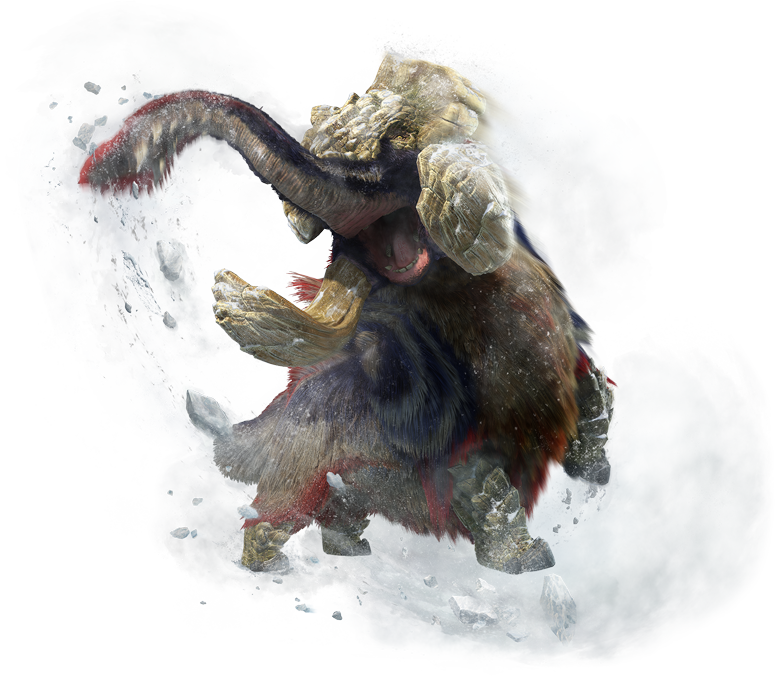
Gammoth
Gargantuan beast (fanged), unaligned
- Armor Class 18 (natural armor)
- Hit Points 198 (12d20 + 72)
- Speed 40 ft.
STR DEX CON INT WIS CHA 22 (+6) 10 (+0) 23 (+6) 8 (-1) 12 (+1) 6 (-2)
- Saving Throws Str +11, Con +11, Wis +6, Cha +3
- Damage Immunities bludgeoning, piercing, slashing from nonmagical weapons
- Damage Resistances cold; bludgeoning, piercing, slashing from magical weapons
- Senses passive Perception 11
- Languages -
- Challenge 16 (15,000 XP)
Trampling Charge. If the gammoth moves at least 20 feet straight toward a creature and then hits it with a gore attack on the same turn, that target must succeed on a DC 19 Strength saving throw or be knocked prone. If the target is prone, the gammoth can make one stomp attack against it as a bonus action.
Ice Walk. The gammoth can move across and climb icy surfaces without needing to make an ability check. Additionally, difficult terrain composed of ice or snow doesn't cost it extra moment.
Actions
Multiattack. The gammoth makes two attacks; one tusk attack and one trunk attack.
Tusk. Melee Weapon Attack: +11 to hit, reach 10 ft., one target. Hit: 13 (2d6 + 6) piercing damage.
Stomp. Melee Weapon Attack: +11 to hit, reach 5 ft., one target. Hit 24 (4d8 + 6) bludgeoning damage.
Trunk. Melee Weapon Attack: +11 to hit, reach 15 ft., one target. Hit 15 (2d8 + 6) bludgeoning damage and the target is grappled (escape 19).
Fling. One Large or smaller object held or creature grappled by the gammoth is thrown up to 60 feet in a random direction and knocked prone. If a thrown target strikes a solid surface, the target takes 3 (1d6) bludgeoning damage for every 10 feet it was thrown. If the target is thrown at another creature, that creature must succeed on a DC 21 Dexterity saving throw or take the same damage and be knocked prone.
Cold Breath (Recharge 5-6). The gammoth exhales an icy blast in a 60-foot cone. Each creature in that area must make a DC 19 Constitution saving throw, taking 41 (9d8) cold damage on a failed save, or half as much damage on a successful one.
Legendary Actions
The gammoth can take 3 legendary actions, choosing from the options below. Only one legendary action option can be used at a time and only at the end of another creatures turn. The gammoth regains spent legendary actions at the start of its turn.
Detect. The gammoth makes a Wisdom (Perception) Check.
Crush. The gammoth makes a stomp attack.
Fling (Costs 2 Actions). The gammoth uses its fling.
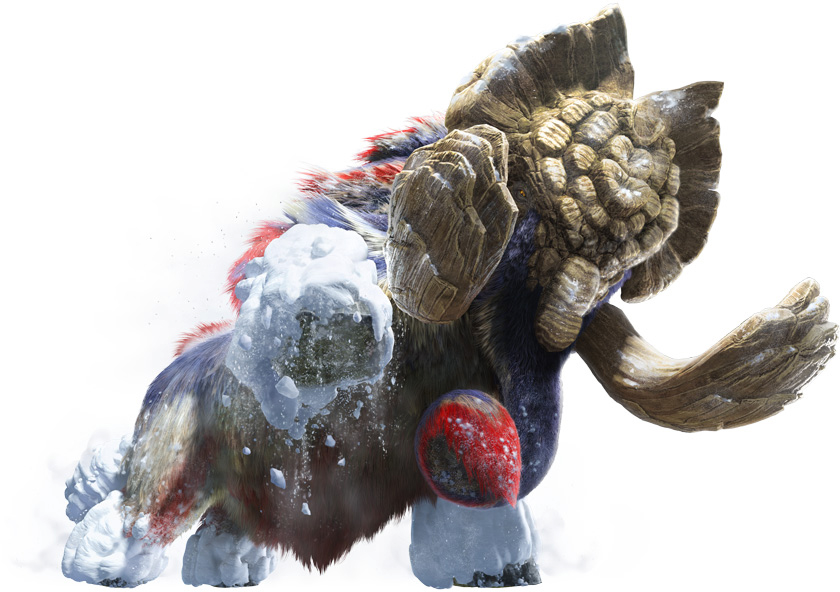

Thank you
For
Checking this out
Thank you all for using this Monster hunter Monster Manual. I created a few monsters originally because I wanted to use them in my own campaign and progressed into this Monster Manual we have today.
This section is 9 pages of monsters from the series and I am pretty proud to say I created them. I hope you all enjoy using these creatures as much as I plan too and this is not the end.
The Monster Manual might be done, but thanks to a few ideas from users on Reddit. I plan on creating a compendium with loot tables for materials, all of the weapons from the videogame series, and rules for using these monsters in your own Monster Hunter D&D game.
If you are interested in letting me know what you think. Feel free to stop by my Twitch channel or check out my Patreon. Thank you for reading and I hope this book serves you well.
Art
Most art, except the cover art, has been gathered from https://monsterhunter.wikia.com website and edited if needed to fit the page. The few others are listed below.
Lore
Most Lore, about these monsters, was also gathered from https://monsterhunter.wikia.com and then edited to omit any mention of missing skills and make the lore more in line with a D&D setting.